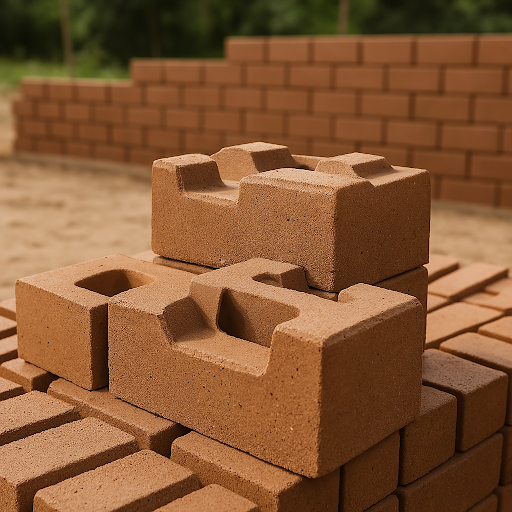Interlocking bricks have become one of the most popular choices in modern construction due to their ease of use, efficiency, and environmental benefits. Whether you’re building a wall, paving a driveway, or constructing a house, selecting the right interlocking brick for your project is critical. This guide will take you through everything you need to know about interlocking bricks, from their types to key considerations when making a decision.
What Are Interlocking Bricks?
Interlocking bricks, also known as interlocking pavers, are specially designed bricks that fit into each other without the need for mortar or adhesives. They’re engineered to interlock in a way that enhances the structural integrity of the construction. These bricks are commonly used in pavements, walls, and even large-scale construction projects due to their strength, cost-effectiveness, and environmental friendliness.
Types of Interlocking Bricks
Before deciding on the best interlocking brick for your project, it’s essential to understand the different types available. Each type of interlocking brick serves a specific purpose, and choosing the wrong one can lead to unnecessary costs or project failure.
1. Concrete Interlocking Bricks
Concrete is the most common material used for interlocking bricks. It is durable, readily available, and relatively inexpensive. Concrete interlocking bricks come in various shapes, sizes, and colors, making them a versatile choice for almost any construction project. They are ideal for roads, walkways, patios, and garden walls.
Benefits of Concrete Interlocking Bricks:
- Cost-Effective: Concrete is relatively affordable compared to other materials.
- Durability: Concrete bricks are highly durable and can withstand heavy loads and harsh weather conditions.
- Versatility: Available in various shapes and sizes to suit different construction needs.
2. Clay Interlocking Bricks
Clay interlocking bricks offer a natural, aesthetic appeal that concrete cannot match. These bricks are fired at high temperatures, which makes them more durable and resistant to weathering. Clay bricks are often used for creating beautiful garden walls, decorative paths, and other aesthetically pleasing features.
Benefits of Clay Interlocking Bricks:
- Aesthetic Appeal: Clay bricks offer a rich, natural color palette that improves the overall look of a structure.
- Weather Resistance: Clay bricks are resistant to fading and are less affected by weathering over time.
- Sustainability: Clay is an eco-friendly material, making it a great choice for environmentally conscious builders.
3. Plastic Interlocking Bricks
Plastic interlocking bricks are relatively new in the market but are gaining traction due to their eco-friendly nature. These bricks are made from recycled plastic, which helps reduce waste while providing a durable solution for construction projects.
Benefits of Plastic Interlocking Bricks:
- Sustainable: Made from recycled materials, these bricks are a great choice for green building projects.
- Lightweight: Plastic bricks are lighter than concrete or clay, making them easier to handle during construction.
- Non-Cracking: Unlike concrete, plastic bricks are not prone to cracking, making them ideal for environments with frequent temperature fluctuations.
Key Considerations When Choosing Interlocking Bricks
Choosing the right interlocking brick requires careful consideration of various factors. Let’s dive into the key points you should keep in mind:
1. Purpose of Construction
The purpose of your construction project plays a crucial role in determining the right type of interlocking brick to use. For example, if you’re working on a heavy-duty application like a driveway, road, or large-scale commercial construction, you’ll need a brick that can withstand heavy traffic and extreme wear. Concrete interlocking bricks are often the best option in such cases due to their strength and load-bearing capacity. On the other hand, for decorative uses such as garden paths, patio paving, or garden walls, the aesthetic qualities of the brick may become a higher priority. Here, clay or even plastic interlocking bricks might be more suitable as they offer enhanced visual appeal without compromising durability. Understanding the intended purpose ensures you choose a brick that meets both functional and design needs, making your project more successful in the long term.
2. Durability and Weather Resistance
Durability is one of the most important factors when selecting interlocking bricks, especially if your project will be exposed to extreme weather conditions or heavy traffic. Concrete bricks are known for their robustness, capable of withstanding intense sun, rain, and frost, making them ideal for driveways, walkways, and roads. Clay bricks, while durable, may not be as resilient in freeze-thaw conditions and could crack under certain weather extremes. However, they offer excellent resistance to fading and weathering over time. Plastic bricks, while lighter, perform well in warm climates and resist cracking, but may not be the best choice for areas with severe weather or high traffic. Therefore, assessing your climate and the amount of wear your construction will endure is crucial in choosing the right material for durability and weather resistance.
3. Aesthetic Requirements
Aesthetic considerations are an important part of the decision-making process, particularly for projects that aim to enhance the beauty of a space. Clay interlocking bricks are highly regarded for their natural and rich color palette, offering warm earth tones that blend beautifully with outdoor settings. These bricks are perfect for creating charming garden walls or intricate patio designs. Concrete bricks, on the other hand, are incredibly versatile and come in a wide variety of colors, textures, and finishes, allowing you to customize your project to match any style. While plastic bricks tend to offer fewer color options, their clean and modern look can still provide a sleek appearance for contemporary landscaping or low-maintenance applications. Ultimately, choosing bricks that complement your project’s design aesthetic helps to ensure that the end result is both functional and visually appealing.
4. Size and Shape
The size and shape of interlocking bricks are essential factors that affect the final layout and ease of installation. Rectangular and square bricks are the most common and versatile options, providing simplicity and uniformity for standard projects such as driveways and walkways. These shapes interlock easily, making them ideal for faster installation. However, for more intricate designs, you may choose custom-shaped bricks such as hexagonal, circular, or diamond shapes, which can create more unique and artistic patterns. The size of the bricks is also important—larger bricks cover more surface area, reducing installation time and material costs, while smaller bricks may be more suitable for detailed, intricate designs. Selecting the right size and shape not only impacts the aesthetic appeal but also influences the overall installation process, so it’s important to choose based on the desired outcome and your project’s complexity.
5. Cost and Budget
Budget is always a crucial factor in construction projects, and it can significantly influence your choice of interlocking bricks. Concrete bricks are typically the most affordable option, making them a go-to for large projects where cost efficiency is a priority, such as roads, driveways, and public walkways. Clay bricks are generally more expensive, due to the material’s natural aesthetic and the firing process required for their production. These bricks may be the right choice if the visual appeal and durability over time justify the higher cost for more decorative or residential projects. Plastic bricks, while eco-friendly, can be the priciest option, mainly because of the recycling process involved in their production. It’s important to balance quality and budget by assessing the longevity, maintenance, and long-term cost-effectiveness of the materials, ensuring that you don’t compromise on durability or functionality to stay within budget.
How to Install Interlocking Bricks
Once you’ve selected the right interlocking bricks, the next step is installation. Although interlocking bricks don’t require mortar, it’s important to follow the correct procedure to ensure a durable and stable structure.
Step-by-Step Installation Process:
- Prepare the Site: Clear the area of any debris, grass, or old pavement. Ensure that the ground is level to avoid uneven installation.
- Create a Sub-Base: Add a layer of gravel or crushed stone to provide drainage and stability for the bricks.
- Lay the Bricks: Start laying the bricks from one corner, ensuring that each brick interlocks with the next. Use a rubber mallet to tap them into place.
- Cut the Bricks: If necessary, cut the last row of bricks to fit the desired space. A wet saw can be used for cutting concrete or clay bricks.
- Fill Gaps: After the bricks are laid, fill the gaps between them with sand or polymeric sand to lock the bricks in place.
- Compact the Surface: Use a plate compactor to ensure that the bricks are tightly secured and the surface is level.
Advantages of Interlocking Bricks
Here are some of the top benefits of using interlocking bricks in construction:
- No Mortar Needed: Interlocking bricks eliminate the need for mortar, making installation faster and cheaper.
- Durability: Interlocking bricks are strong and can withstand a variety of environmental conditions, making them ideal for both residential and commercial construction.
- Environmentally Friendly: Many interlocking bricks, especially plastic bricks, are made from recycled materials, making them a sustainable option.
- Cost-Effective: Since the installation process is quicker and more affordable, interlocking bricks offer long-term cost savings.
Conclusion
Choosing the right interlocking bricks for your construction project is a decision that requires careful consideration of factors like material, purpose, durability, and cost. By understanding the different types of interlocking bricks available, as well as the key considerations for your specific needs, you can make an informed decision that ensures your construction project is both functional and aesthetically pleasing.
Whether you’re building a patio, constructing a retaining wall, or paving a driveway, interlocking bricks are a durable, cost-effective, and sustainable choice that will serve you well for years to come. So, take your time, evaluate your options, and choose the best interlocking bricks for your project.









































